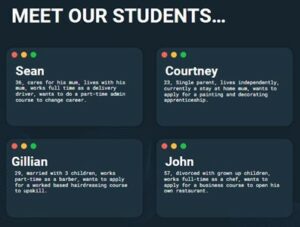 A thought piece by Amy Monks, Dundee and Angus College
A thought piece by Amy Monks, Dundee and Angus College
I discovered Service Design as a new beauty student at Dundee and Angus College in 2018, taking part in a Service Design Academy workshop. I collaborated with other students and staff to find out what was needed in the Hair and Beauty department to remain industry relevant and to improve the student experience.
I fell in love with Service Design! The process and the methodology – designing with not just for people – made so much sense to me. By 2021, I had finished four years of study, served as Vice president of the Students’ Association for two years and graduated with a Professional Development Award in Service  Design.
Design.
As I began a two-year, full-time position as Student President I took every opportunity to use Service Design to bring the students’ voice to the heart of everything we do at the Students’ Association. From Class Rep training to team meetings to our office spaces, we use service design tools and methods to improve our services for the better. We could see that understanding our students’ needs and designing services with them made a stronger and positive impact.
High-level decision-making is critical to the College’s success, but I believe it’s always important to never lose sight of who these decisions ultimately impact: our students. They are the people at the heart of our Colleges, and we must support them by understanding their needs for them to succeed.
With this front of mind in my last week as Student President, I facilitated a session at Dundee and Angus College Board of Management Strategy Day in May 2023. I wanted to ensure that the student voice was heard and understood, supporting Board members to engage with this central community.
My goal was for the group to empathise with the students to understand the effects of decisions made around the Board and College table. The group needed to grasp the barriers students face when considering starting at College – both their feelings and the influence of their surroundings. What do students consider when deciding whether college is right for them? This understanding would enable us to provide better support in learning, teaching, and pastoral care.
 Before the session, I asked a group of our students two questions:
Before the session, I asked a group of our students two questions:
What mattered most to you in the past year?
What do students value most for their future at college?
At the session, I posed this question again to our Board members and guests, asking them to speculate on what students might have prioritised. Equipped with post-its and pens, the group had one minute to jot down their assumptions.
Some answers aligned, but a few were surprises! The room revealed diverse perspectives on the importance of travel, mental health, family, finances and friendships, emphasising that everyone values different things just like our students do.
Moving on to the second question: What do students value most for their future at college?
This time, I shared our students’ answers with the group. This insider information would assist them in their main task: an Empathy Map. This tool from the Service Design Academy helps individuals fully immerse themselves in someone else’s shoes, considering their emotions, fears, hopes, and aspirations. While many thoughts will be assumptions, I encouraged an open and non-judgmental approach, to uncover hidden barriers faced by many individuals.
 Working in teams, the Board were given one student bio with a description of someone who was thinking about studying at college in the upcoming academic year. This technique allowed them to start thinking about what it feels like to walk in someone else’s shoes.
Working in teams, the Board were given one student bio with a description of someone who was thinking about studying at college in the upcoming academic year. This technique allowed them to start thinking about what it feels like to walk in someone else’s shoes.
My final question to the group was: “What can we do to make students feel like they belong and become successful?“ Each group shared their responses, allowing others to hear about students’ lives and how the college can support them in achieving their goals.
The answers from the room were similar: support, reassurance, personalised approach, and security. Students’ needs must be met where they are on their journey; a one-size-fits-all approach leaves gaps. To achieve this, we need confident and capable staff, an innovative and flexible college, and government funding that promotes growth and enhances skills across Scotland.
My reflections:
Some participants, unfamiliar with our culture, found the session challenging. It pushed them out of their comfort zone and made them feel vulnerable. This in itself was a literal embodiment of the task to empathise with students – it’s how many students feel when they first come to college, full of nerves and unsure of expectations. This gave students a voice, uncovering difficulties unknown before and helping make their experiences real to others.
By stepping into students’ shoes, participants started to open their minds and hearts to envision real lives. My hope as the facilitator is that all the people present left with a reinvigorated purpose on why we work in the college sector. Where can they influence change and why so much work is being done by college staff to keep our organisations thriving and sustainable. It’s for our students, our people.
You can find out more about the Service Design Academy and what we do to train and educate people to design better services here https://www.sda.ac.uk/








